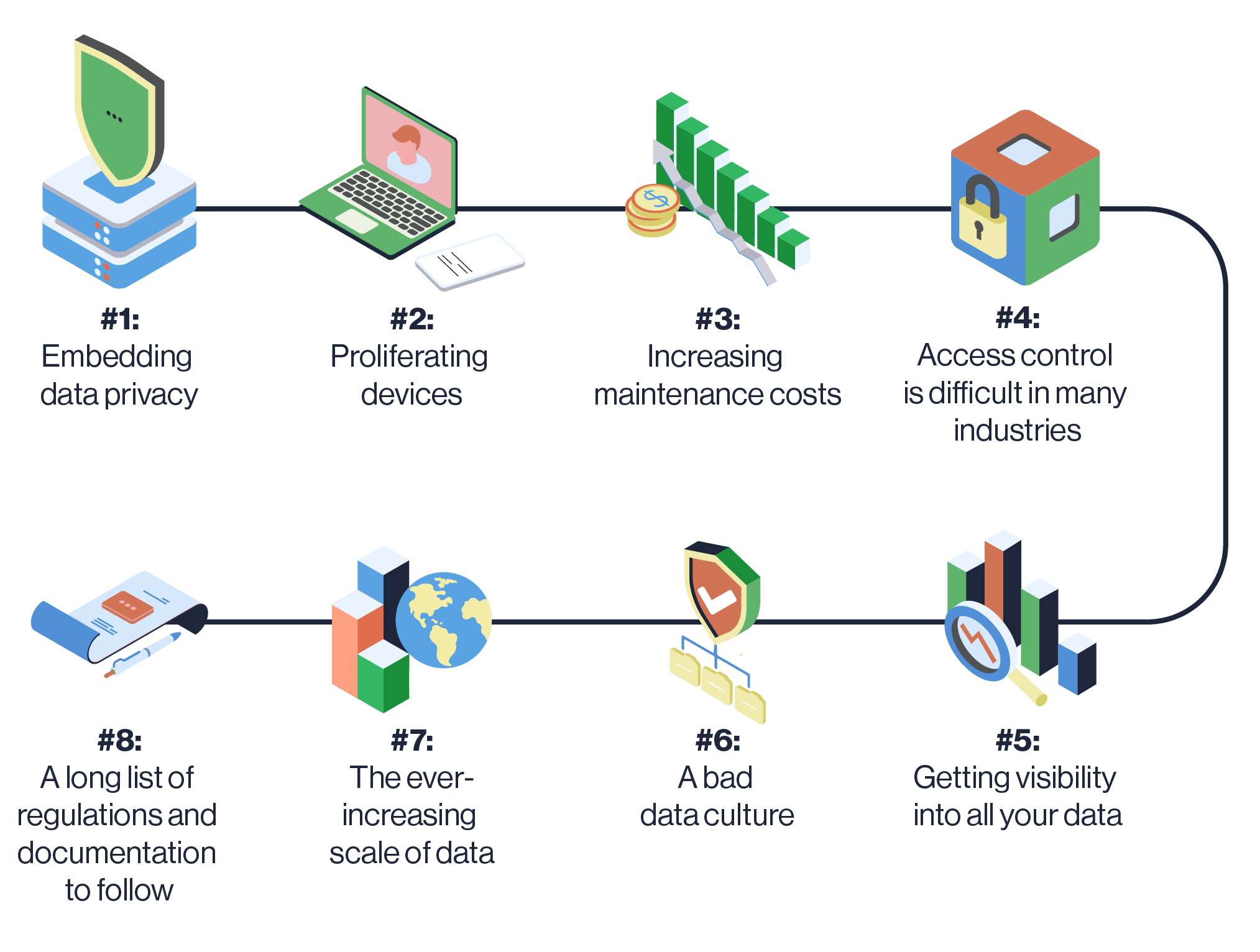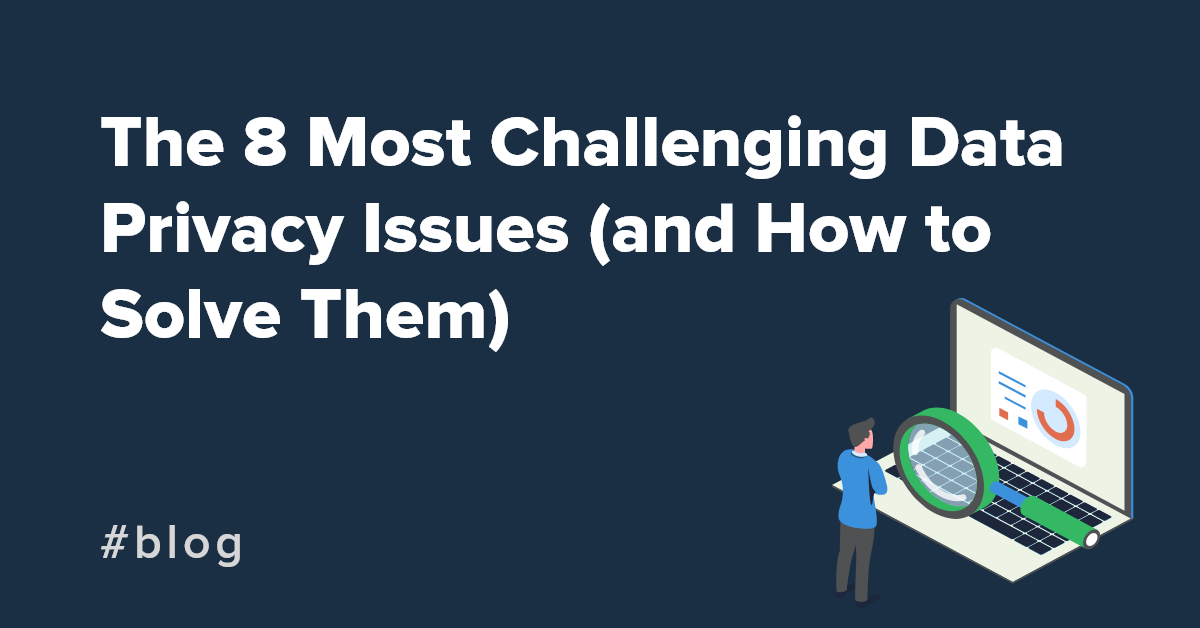In today’s world, ignoring data privacy issues is like a sailor turning a blind eye to rising seas and a falling barometer.
Increasing use (and abuse) of personal data puts data privacy at the top of your business’s risk management agenda. It is an escapable challenge and dangerous to ignore.
Breaching GDPR and other regulations, such as CCPA and HIPAA, comes with hefty fines. What’s more, the reputation damage can be an existential threat to your business and a career limiting blot on an IT manager’s resumé.
But what exactly are the most challenging data privacy issues, and how do you solve them?
Here are eight of the most important.

Download the article as a pdf
Share it with colleagues. Print it as a booklet. Read it on the plane.
#1: Embedding data privacy
Unfortunately, many businesses only have data privacy tacked onto their IT security or disaster recovery plan. But that’s not good enough because data privacy touches on so many parts of your business.
You can’t afford to treat privacy as an afterthought. It needs to be baked into the heart of your data strategy and staff training. It’s not easy, so ensure you collaborate with and get buy-in from all departments. Make sure you choose tools that support your current privacy policies, for example by making data anonymization easier.
#2: Proliferating devices
Data privacy becomes harder to handle when you factor in things like the Internet of Things (IOT), bring-your-own-device IT policies and proliferating internet-connected tablets, phones and watches. When you bring more devices into the workplace, you end up having more data to manage.
Your organization must be able to manage compliance and data privacy from any source, different operating systems and multiple apps. To remedy this, ensure you have the right data governance procedures in place.
#3: Increasing maintenance costs
Keeping your systems secure and preventing data privacy issues at the enterprise level can be expensive. But, the costs of a data breach are so significant, you need to bite the bullet and invest properly.
That’s why automating processes is so important. It helps in different ways:
- Reducing the number of data silos
- Eliminating points of friction and manual processing
- Reducing the risk of human error
- More opportunities for de-duplication
- Improved governance and control
- Lower costs
#4: Access control is difficult in many industries
Data privacy breaches are often caused by poorly managed access within an organization. People and processes matter as much as technology. Humans are the weakest link in the chain of privacy and security.
However, as distributed working proliferates, it’s harder to manage user access and secure your sensitive data. To remedy this, you need an effective data architecture and strong data governance processes.
#5: Getting visibility into all your data
If your organization isn’t aware of the location, nature, and sensitivity of your data, how can you possibly keep the right information private?
Using tools to discover and classify your data is essential. This will ensure you can treat data uniquely and protect your sensitive data from any privacy issues.
#6: A bad data culture
A miser’s hoard of data is increasingly a risk rather than an asset. The days when it made sense to hold onto as much data as technologically possible are over. In the past, thanks to ‘big data’ hype, many organizations and IT leaders believed that more data is always better. That’s no longer automatically true.
Today, keeping data for its own sake broadens the attack surface for data theft and increases the risk of breaching many data privacy laws. Forward-thinking IT teams need to balance the value of collecting, storing and processing large volumes of data against the pressing requirements for privacy, security and compliance.
Instead, build a great data culture that understands the value of data and data privacy.
#7: The ever-increasing scale of data
As cloud storage and compute costs come down, businesses are now swimming (or drowning) in data.
Indeed, as the amount of global data grows (and is now tracked in the tens of zettabytes), the challenge of managing these oceans of data is huge.
With hundreds of systems and millions of data records, you need a solution that can handle the scale.
#8: A long list of regulations and documentation to follow
With so many regulations to follow, it can be difficult to keep track of what level of data privacy you need to achieve for your different datasets.
By building processes, data modeling, and automating as much as possible, you can make it easier to handle the complexity of different regulations.
Are you taking risks with data privacy?
From an evolving technology landscape, to gaining visibility into all your data infrastructure, there are plenty of data privacy challenges your modern business must tackle.
But, if you follow the advice we’ve covered, you’ll be well-positioned to handle your data privacy issues.
However, removing all the danger from your data isn’t a quick-fix solution. For example, many organizations hold onto their data for too long. This is a problem because data value decreases over time, but the costs and risks attached to it don’t.
To learn more about how you can de-risk your data, remove privacy issues, and make your data a real asset for your business, watch our webinar on removing danger from data.










